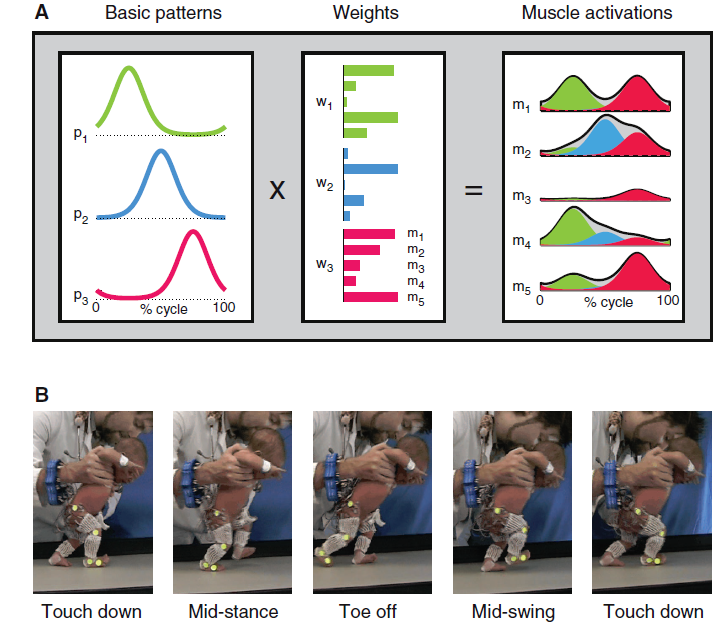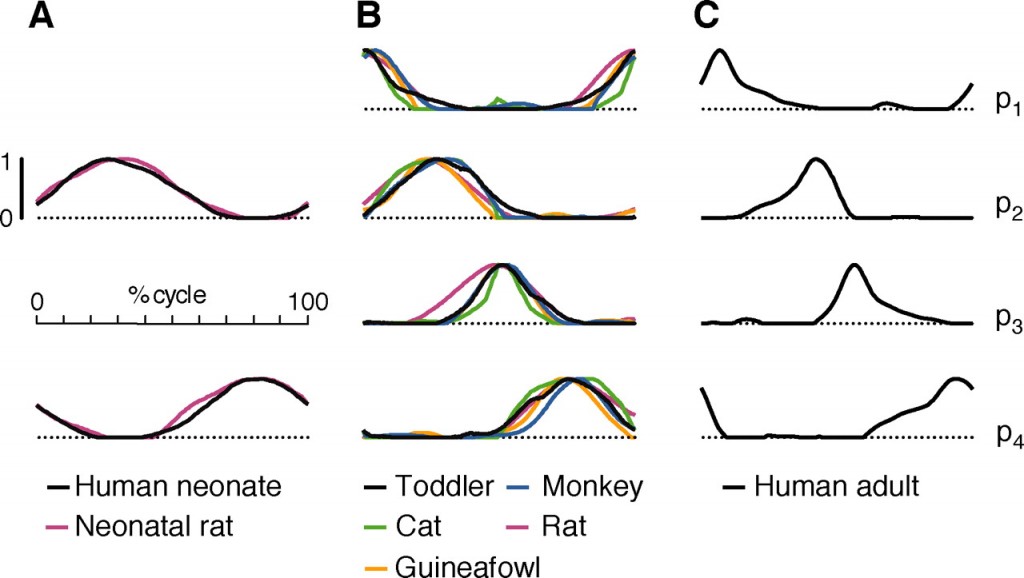Primitives. Hey! What do you mean by “Primitives”?!
According to Giszter et al. (2010), the “term ‘primitive’ may best indicate the idea of a set of building blocks or developmental bootstrap elements that is used in a constructive or compositional fashion” from which “larger modules can be made.”
Thus, these primitive building blocks can be hypothesized to define modules of muscle activations that are a combination of basic patterns and weights distributed to the muscles composing the module (see Lacquaniti et al. 2012).

Fig. 1. (A) Schematic of motor modules (m). Simulated example of muscle activity profiles as weighted (w) sum of basic patterns (p): mi(t)=Σjpj(t)wij. The outputs of the first (green), second (blue), and third (magenta) modules are summed together (i = 5, j =3) to generate overall muscle activation (black envelope). (B) Illustration of a step cycle in a 3-day-old newborn.
Above is Fig. 1 from Dominici et al. (2011). Furthermore, they state,
“Thus, the electromyographic (EMG) activity of trunk and leg muscles during human adult locomotion is explained by few basic patterns independent of locomotion mode, direction, speed, and body support ([Grillner 1985, Ivanenko et al. 2004, Bizzi et al. 2008]). These patterns may be regarded as locomotor primitives in a computational sense, because they are the building blocks from which locomotor activities are constructed. But are they primitives also in a developmental sense—that is, are they related to precursors present at or before birth?” [References clarified and emphasis added]
First, let’s look at the adult patterns. There are as few as four main patterns and more as other muscles are monitored and allowed to be part of the pattern analysis.
| Dominici et al. | Chvatal & Ting | Function | Timing | Major muscle contributions |
| P1 | P1 | Body support and propulsion | Early stance | Rectus femoris, Vastus medialis, Vastus lateralis |
| P2 | P2 | Plantar flexion/ body support and propulsion | Mid-late stance | Gastrocnemius medialis, Gastrocnemius lateralis, Soleus |
| P3 | P4 | Ankle dorsiflexion/ eversion, leg deceleration | Early swing and swing-to-stance transition | Adductor magnus, Peronius, Tibialis anterior |
| P4 | P5 | Leg deceleration | Late swing/early stance | Tibialis anterior, Adductor magnus, Semitendinosus, Biceps femoralis, long head |
| P3 | Trunk extension/adduction | Late stance | Erector spinae, Gluteus medius, Adductor magnus |
|
| P6 | Trunk flexion/abduction | Early stance and throughout gait cycle | Rectus abdominis, Abdominal external oblique, Tensor fasciae latae |
Lacquaniti et al. (2012) made the following comments, based on studies shown In the table above:
- Pattern no. 1 (P1, primarily hip and knee extensors) contributes to weight acceptance at heel contact in early stance,
- Pattern no. 2 (P2, ankle plantar flexors) contributes to body support and forward propulsion in late stance,
- Pattern no. 3 (P3, ankle dorsiflexors and hip flexors) contributes to foot lift-off in early- to mid-swing, and
- Pattern no. 4 (P4, hamstrings [and tibialis anterior]) decelerates the leg in late swing in preparation for heel contact and then stabilizes the pelvis after contact.
Well. What about the primitives? Dominici et al. (2012) found some really amazing results shown below:
- Newborns at 3 days old, could step if gently pulled along a walkway as shown in Fig. 1 but showed EMG activity for only lower limb muscles, with two patterns, no. 2 and no. 4, peaking at midstance and midswing.
- Totters at 11 to 14 months, added upper leg and trunk muscles activity corresponding to patterns no. 1 and no. 3, peaking at each foot contact.
- Adults keep their legs “much straighter than in children, and the planar covariation of segment motion was adjusted to fully exploit the inverted pendulum mechanism, with minimum muscle activity to support and propel the body.”

Fig. 4 Comparison of activation patterns for locomotion in humans and other vertebrates. (A) Average patterns of human newborns are superimposed on those of neonatal rats; (B) patterns of human toddlers are superimposed on those of adult rats, cats, monkeys, and guinea fowls; and (C) patterns of human adults stand alone.
“These observations,” Dominici and co-investigators wrote, “beg the question: Are the basic motor patterns unique to humans, or are they shared by other vertebrates with legged terrestrial locomotion? We applied the same analysis used in humans to the published recordings available from a few other mammals (rat, cat, rhesus monkey) and a bird (guinea fowl).”
Thus, in their Fig. 4 above, the neonatal rat showed the same two patterns as the human neonates! And more surprising, the other animals had the same four patterns for the toddler!!!! Only us human adults had smoothed patterns showing conservation of energy expenditure. Also they surmised that,
“The human developmental path appears to diverge from that of other animals after the stage of independent locomotion in toddlers, perhaps to accommodate discrete arm movements (such as reaching and grasping an object) within rhythmic locomotion …. Upper limb and trunk muscles can be engaged independently of locomotor activations (involving some of the same muscles) only if the latter occur as the brief events of adults ….”
Our take home message is what Dominici et al. (2012) concluded, “Locomotion in humans and other species may be built starting from common, largely inborn primitives.”
Next week will be some answers to “What activates the patterns and modifies the weight distributed to the muscles involved?” And “What sets the intensity for the modules?”
References
Bizzi E, Cheung VCK, d’Avella A, Saltiel P, Tresch M. (2018) Combining modules for movement. Brain Res Rev 57: 125-133.
Chvatal SA, LH Ting. (2012) Voluntary and reactive recruitment of locomotor muscle synergies during perturbed walking. J Neuroscience 32: 12237-12250.
Dominici N, Ivanenko YP, Cappellini G, d’Avella A, Mondì V, …, Lacquaniti F. (2012) Locomotor primitives in newborn babies and their development. Science 334: 997-999.
Giszter S, Hart C, Silfies SP. Spinal cord modularity: evolution, development, and optimization and the possible relevance to low back pain in man. Exp Brain Res 200: 283-306.
Grillner S. (1985) Neurobiological bases of rhythmic motor acts in vertibrates. Science 228: 143-149.
Ivanenko YP, Poppele RE, Lacquaniti F. (2004) Five basic muscle activation patterns account for muscle activity during human locomotion. J Physiol 556: 267-282.
Lacquaniti F, Ivanenko YP, Zago M. (2012) Patterned control of human locomotion. J. Physiol 590: 2189-2199.